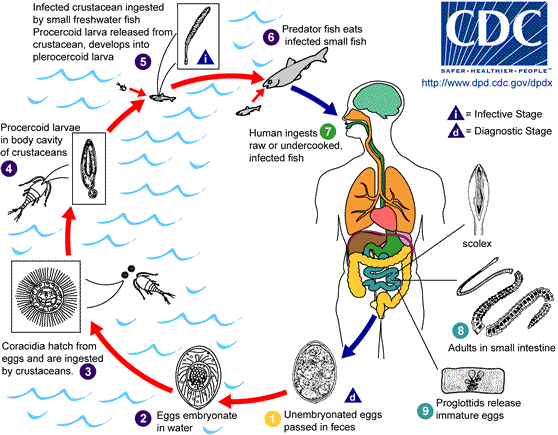Diphyllobothrium Dendriticum on:
[Wikipedia]
[Google]
[Amazon]
''Diphyllobothrium dendriticum'' is a large  Text was copied from this source, which is available under
Text was copied from this source, which is available under
Creative Commons Attribution 4.0 International License
For many years ''D. dendriticum'' infection was neglected. Diphyllobothriasis is not a life-threatening disease and most human cases are mild or even asymptomatic. The original distribution of ''D. dendriticum'' is
 The life cycle of ''D. dendriticum'' is similar to life cycles of other ''
The life cycle of ''D. dendriticum'' is similar to life cycles of other ''
pseudophyllid
Pseudophyllid cestodes (former order pseudophyllidea) are tapeworms with multiple "segments" (proglottids) and two bothria or "sucking grooves" as adults. Proglottids are identifiably pseudophyllid as the genital pore and uterine pore are locat ...
cestode
Cestoda is a class of parasitic worms in the flatworm phylum (Platyhelminthes). Most of the species—and the best-known—are those in the subclass Eucestoda; they are ribbon-like worms as adults, known as tapeworms. Their bodies consist of man ...
of the family ''Diphyllobothriidae
Diphyllobothriidea is a family of Cestoda (tapeworms). Members of this family are gut parasites of vertebrates. In most species the definitive hosts are marine or aquatic mammals such as cetaceans and pinnipeds, the first intermediate host usual ...
''. Creative Commons Attribution 4.0 International License
For many years ''D. dendriticum'' infection was neglected. Diphyllobothriasis is not a life-threatening disease and most human cases are mild or even asymptomatic. The original distribution of ''D. dendriticum'' is
circumboreal
The Circumboreal Region in phytogeography is a floristic region within the Holarctic Kingdom in Eurasia and North America, as delineated by such geobotanists as Josias Braun-Blanquet and Armen Takhtajan.
It is the largest floristic region in t ...
, but it was also found in Argentina and Chile.
Life cycle
 The life cycle of ''D. dendriticum'' is similar to life cycles of other ''
The life cycle of ''D. dendriticum'' is similar to life cycles of other ''Diphyllobothrium
''Diphyllobothrium'' is a genus of tapeworms which can cause diphyllobothriasis in humans through consumption of raw or undercooked fish. The principal species causing diphyllobothriasis is ''D. latum'', known as the broad or fish tapeworm, or b ...
'' species, all of which include three hosts. Freshwater copepods serve as the first intermediate hosts; fish serve as the second intermediate hosts. Moreover, many predator fish species can be paratenic hosts for Diphyllobothriidae, i.e., accumulate plerocercoids (the larval stage that infects definitive hosts) in muscles and internal organs.
Eggs are passed unembryonated in feces. Under appropriate conditions, the eggs mature and yield oncosphere which develop into a coracidia. Planktonic copepods
Copepods (; meaning "oar-feet") are a group of small crustaceans found in nearly every freshwater and saltwater habitat. Some species are planktonic (inhabiting sea waters), some are benthic (living on the ocean floor), a number of species have p ...
serve as the first intermediate hosts in which the larval stage, called procercoid develops. The second larval stage or metacestode, called plerocercoid, develops in second intermediate host, freshwater and anadromous fishes, especially salmonids. Because humans do not generally eat these small fish species raw, the second intermediate host probably does not represent an important source of human infection. However, these small second intermediate hosts can be eaten by larger predator species that then serve as paratenic host. Plerocercoid larvae is the infectious stage for the definitive host. Plerocercoids of ''D. dendriticum'' are usually encysted within the visceral organs or body cavity. Humans can become infected either by consuming raw or undercooked visceral organs, such as liver and ovaries.
See also
* List of parasites (human)References